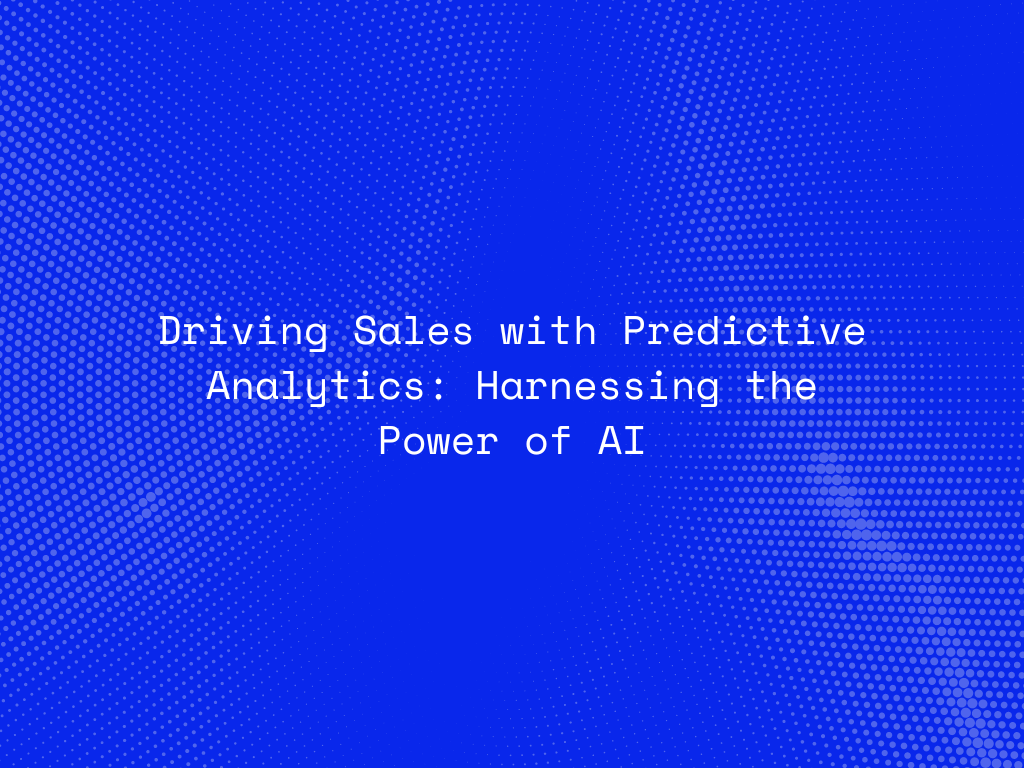In today’s highly competitive market, businesses are constantly seeking new ways to stay ahead of the curve and drive sales. One of the most powerful tools at their disposal is predictive analytics, a branch of artificial intelligence (AI) that uses historical data to predict future outcomes. By leveraging predictive analytics, companies can gain valuable insights into customer behavior, optimize marketing strategies, and ultimately boost their sales performance. In this blog, we’ll explore how predictive analytics works, its benefits, and how businesses can harness this technology to drive sales growth.
Understanding Predictive Analytics
Predictive analytics involves using statistical algorithms and machine learning techniques to analyze historical data and make predictions about future events. This approach goes beyond simply analyzing past trends; it identifies patterns and correlations that can be used to forecast future behavior, helping businesses make data-driven decisions.
Key components of predictive analytics include:
-
Data Collection
- Predictive analytics relies on large volumes of data, which can come from various sources, including customer transactions, social media interactions, website activity, and CRM systems. The more comprehensive the data, the more accurate the predictions.
-
Data Processing
- Once collected, the data is cleaned, organized, and processed to ensure it is suitable for analysis. This involves removing duplicates, handling missing values, and transforming the data into a format that can be used by machine learning models.
-
Model Building
- Machine learning models are developed to analyze the data and identify patterns. These models are trained on historical data and validated to ensure they can make accurate predictions. Common techniques used in predictive analytics include regression analysis, decision trees, and neural networks.
-
Prediction and Action
- After the model has been trained and validated, it is used to make predictions about future events. Businesses can then use these predictions to inform their strategies and take proactive actions to achieve their sales goals.
Connect With Us
Benefits of Predictive Analytics in Driving Sales
Predictive analytics offers a range of benefits that can significantly enhance a company’s sales performance:
-
Personalized Marketing
- Predictive analytics allows businesses to segment their customers based on behavior, preferences, and purchase history. This enables the creation of highly targeted marketing campaigns that resonate with individual customers, increasing the likelihood of conversion. For example, by analyzing past purchase data, a retailer can predict which products a customer is likely to buy next and send personalized recommendations or offers.
-
Optimized Pricing Strategies
- By analyzing market trends, competitor pricing, and customer behavior, predictive analytics can help businesses develop dynamic pricing strategies that maximize revenue. For instance, e-commerce platforms can use predictive models to adjust prices in real-time based on demand, inventory levels, and competitor prices, ensuring they remain competitive while maximizing profit margins.
-
Improved Sales Forecasting
- Accurate sales forecasting is critical for effective inventory management, budgeting, and resource allocation. Predictive analytics enhances traditional forecasting methods by incorporating a wider range of variables, such as economic indicators, seasonal trends, and customer sentiment. This leads to more accurate sales predictions, helping businesses plan more effectively and avoid stockouts or overstocking.
-
Lead Scoring and Prioritization
- Not all leads are created equal, and predictive analytics can help businesses identify which leads are most likely to convert. By analyzing factors such as customer engagement, demographic information, and previous interactions, predictive models can assign a score to each lead, indicating their likelihood of making a purchase. Sales teams can then prioritize high-scoring leads, focusing their efforts on those with the highest potential for conversion.
-
Customer Retention and Churn Prediction
- Retaining existing customers is often more cost-effective than acquiring new ones. Predictive analytics can help businesses identify customers who are at risk of churning by analyzing patterns such as declining engagement, negative feedback, or reduced purchase frequency. By identifying these at-risk customers early, businesses can take proactive measures, such as personalized offers or customer support interventions, to improve retention rates.
-
Optimized Product Recommendations
- Predictive analytics powers recommendation engines that suggest products or services based on a customer’s past behavior and preferences. These recommendations are often more relevant and timely, leading to increased cross-selling and upselling opportunities. For example, an online retailer might use predictive models to suggest complementary products when a customer adds an item to their cart, increasing the average order value.
-
Enhanced Customer Lifetime Value (CLV)
- Predictive analytics can be used to estimate the lifetime value of a customer, helping businesses understand which customers are most valuable in the long term. By focusing marketing and sales efforts on high-CLV customers, businesses can maximize their return on investment and build stronger, more profitable customer relationships.
Connect With Us
How to Implement Predictive Analytics for Sales Growth
Implementing predictive analytics requires a strategic approach, including the following steps:
-
Define Clear Objectives
- Before diving into predictive analytics, businesses should define clear objectives that align with their overall sales strategy. Whether the goal is to improve lead conversion, enhance customer retention, or optimize pricing, having a clear focus will guide the implementation process and ensure that predictive analytics delivers meaningful results.
-
Gather and Integrate Data
- Collecting and integrating data from various sources is a critical step in building accurate predictive models. This includes data from CRM systems, sales transactions, marketing campaigns, social media, and other relevant sources. Ensuring that data is clean, consistent, and up-to-date is essential for the success of predictive analytics.
-
Choose the Right Tools and Technologies
- There are various tools and platforms available for predictive analytics, ranging from open-source machine learning libraries to enterprise-grade analytics solutions. Businesses should choose tools that align with their technical capabilities, budget, and specific needs. Additionally, leveraging cloud-based analytics platforms can provide scalability and flexibility as data volumes grow.
-
Develop and Validate Predictive Models
- Building predictive models requires expertise in data science and machine learning. Businesses can either build an in-house team of data scientists or partner with external experts to develop and validate predictive models. It’s important to continuously monitor and refine these models to ensure they remain accurate and relevant over time.
-
Integrate Predictive Analytics into Sales Processes
- To fully leverage predictive analytics, businesses need to integrate insights into their existing sales processes. This could involve using predictive models to inform marketing campaigns, adjusting pricing strategies based on real-time data, or enabling sales teams with predictive lead scoring. Ensuring that sales and marketing teams are trained to interpret and act on predictive insights is crucial for success.
-
Measure and Optimize Performance
- Implementing predictive analytics is not a one-time effort; it requires ongoing measurement and optimization. Businesses should regularly track key performance indicators (KPIs) such as conversion rates, customer retention, and sales growth to assess the impact of predictive analytics. Based on these insights, businesses can refine their strategies and models to continually improve performance.
Connect With Us
Case Studies: Predictive Analytics in Action
To illustrate the power of predictive analytics, let’s look at a few examples of companies that have successfully harnessed this technology to drive sales growth:
-
Amazon
- Amazon’s recommendation engine is one of the most well-known examples of predictive analytics in action. By analyzing customer behavior, purchase history, and browsing patterns, Amazon’s predictive models suggest products that customers are likely to buy. This personalized shopping experience has been a key factor in Amazon’s success, driving significant increases in sales and customer satisfaction.
-
Netflix
- Netflix uses predictive analytics to recommend shows and movies to its users based on their viewing history and preferences. By delivering highly personalized content recommendations, Netflix has been able to increase user engagement, reduce churn, and maintain its position as a leader in the streaming industry.
-
Starbucks
- Starbucks uses predictive analytics to optimize its marketing campaigns and drive customer loyalty. By analyzing customer purchase data, Starbucks can send targeted offers and promotions to individual customers, encouraging repeat visits and increasing average order value. Predictive analytics also helps Starbucks identify the best locations for new stores, ensuring they are positioned to maximize foot traffic and sales.
Conclusion
Predictive analytics is a powerful tool that can significantly enhance a business’s ability to drive sales and achieve sustainable growth. By harnessing the power of AI to analyze data, predict customer behavior, and optimize marketing strategies, businesses can stay ahead of the competition and deliver a more personalized, effective customer experience. As more companies embrace predictive analytics, those that do so strategically will be well-positioned to thrive in an increasingly data-driven world. Whether you’re a small business looking to improve lead conversion or a large enterprise seeking to optimize pricing, predictive analytics offers a wealth of opportunities to boost sales and drive long-term success.




